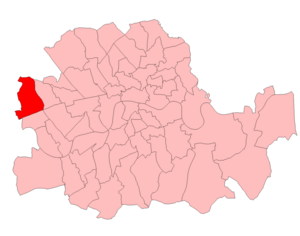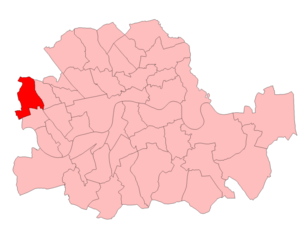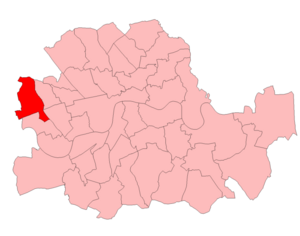Hammersmith North (UK Parliament constituency) facts for kids
Quick facts for kids {{{Name}}}[[{{{Type}}} constituency]] |
|
|---|---|
| [[Image:{{{Map1}}}Constituency.svg|120px|]] [[Image:England{{{Map2}}}.svg|120px|]] |
|
| {{{Name}}} shown within [[{{{Entity}}}]], and {{{Entity}}} shown within England | |
| Created: | {{{Year}}} |
| MP: | {{{MP}}} |
| Party: | {{{Party}}} |
| Type: | House of Commons |
| County: | [[{{{County}}}]] |
| EP constituency: | [[{{{EP}}} (European Parliament constituency)|{{{EP}}}]] |
Hammersmith North was a special area in West London that used to choose its own representative, called a Member of Parliament (MP), to speak for them in the UK Parliament. It was a "borough constituency," which means it was an area within a town or city. People in Hammersmith North voted for one MP using a system called first past the post, where the candidate with the most votes wins.
Contents
History of Hammersmith North
This area for voting was created for the 1918 general election. Before that, it was part of a larger area called Hammersmith.
In its early years, the Hammersmith North seat often changed hands between the Labour Party and the Conservative Party. However, from a special election in 1934 until it was closed down in 1983, it was always represented by a Labour MP.
The constituency was officially ended for the 1983 general election. Parts of it then became part of a new Hammersmith constituency.
Understanding the Boundaries
A constituency's boundaries are like its borders, showing exactly which streets and areas are included for voting. These boundaries can change over time due to population shifts or new laws.
Boundaries from 1918 to 1950
The Hammersmith North constituency was first set up by a law called the Representation of the People Act 1918. It included specific parts of the Metropolitan Borough of Hammersmith known as Wards Four, Five, Six, and Seven.
Boundaries from 1950 to 1955
The original boundaries were used until the 1950 general election. By then, the smaller areas (wards) within the metropolitan borough had been redrawn. So, the constituency was redefined to include six new wards: College Park & Latimer, Coningham, Old Oak, Starch Green, White City, and Wormholt.
Boundaries from 1955 to 1974
Another law, the House of Commons (Redistribution of Seats) Act 1949, allowed for regular checks and changes to constituency boundaries. Before the 1955 general election, the voting areas in Hammersmith and Fulham were changed. The nearby seat of Hammersmith South was removed, and three of its wards – Addison, Olympia, and St. Stephen's – were added to Hammersmith North.
Boundaries from 1974 to 1983
The last change to the constituency's boundaries happened before the February 1974 election. In 1965, the old metropolitan borough became part of the larger London Borough of Hammersmith. The Hammersmith North seat was then defined to include ten wards of this new London Borough: Addison, Broadway, Brook Green, College Park & Old Oak, Coningham, Grove, St. Stephen's, Starch Green, White City, and Wormholt.
Members of Parliament for Hammersmith North
A Member of Parliament (MP) is a person elected by the people in a constituency to represent their views and interests in the House of Commons.
| Election | Member | Party | |
|---|---|---|---|
| 1918 | Sir Henry Foreman | Coalition Conservative | |
| 1922 | Conservative | ||
| 1923 | James Gardner | Labour | |
| 1924 | Ellis Ashmead-Bartlett | Conservative | |
| 1926 by-election | James Gardner | Labour | |
| 1931 | Mary Pickford | Conservative | |
| 1934 by-election | Fielding West | Labour | |
| 1935 | Denis Pritt | Labour | |
| 1940 | Independent Labour | ||
| 1949 | Labour Independent Group | ||
| 1950 | Frank Tomney | Labour | |
| 1979 | Clive Soley | Labour | |
| 1983 | constituency abolished : see Hammersmith | ||
Election Results Overview
Elections are how people choose their representatives. In Hammersmith North, voters went to the polls regularly to decide who would be their MP.
In the early years, the seat was won by both Conservative and Labour candidates. However, after a special election in 1934, the Labour Party held the seat continuously until the constituency was abolished in 1983. This showed a strong and consistent support for the Labour Party in Hammersmith North for many decades.





